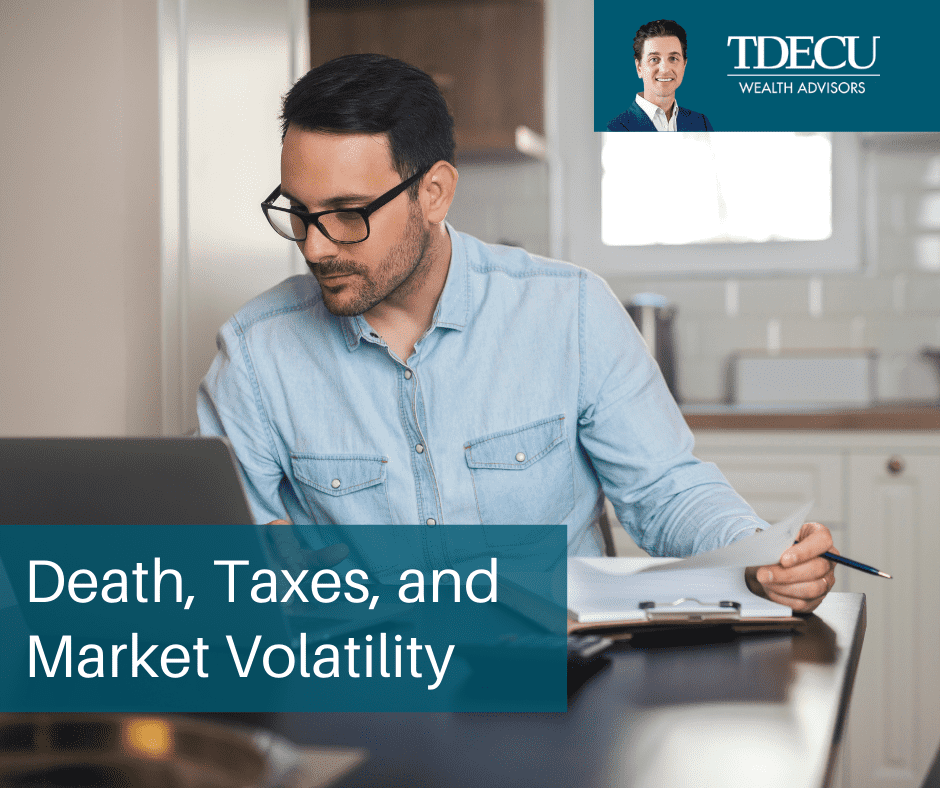"In this world, nothing can be said to be certain, except death and taxes."
When Benjamin Franklin penned this quote, he may have forgotten to add one item to this list -- market volatility. When we invest, we should always be ready for the markets to go up and down; in fact, we should expect it. In most cases, the best course of action is to ride the waves rather than emotionally jumping out during a downward swing.
To give you some background on why we should expect market volatility, check out these facts.
Intra-Year Declines Are Par for the Course
Over the past 50 years, in the S&P 500 Index, the average intra-year decline is 13.8%. In other words, the average investor sees their S&P 500 stocks fall by nearly 14% at least once during the year and since 1950, the S&P 500 has declined about 33% on average once every five years. Although it can be scary to watch your nest egg drop in value, the good news is that these pullbacks tend to adjust themselves, and historically, the markets have recovered from these temporary declines 100% of the time.
The Stock Market Trends Upward
To see the upward trends in the market, it helps to zoom out and look at growth over a number of decades. For example, over the last 70 years, since 1950, the S&P 500 has averaged over 11% growth per year.
But to potentially enjoy these average returns, it is recommended that you stay in the market for the long run. There is an old industry adage: it’s not timing the market, but time in the market that counts.
Although the market does not increase every year, it enjoys growth most years. Over the last 50 years, the markets have shown positive growth in 40 years or 80% of the time.
The Market Can Recover From Significant Drops Quickly
In some cases, investors see a substantial decline in their portfolios over such a short time period that they can be tempted to sell and 2020 had one of those periods. During the worst point of the COVID-19 shut down, on March 23, 2020, the S&P 500 had fallen by 34% compared to its value on February 19 when it closed at an all-time high. One day shy of six months later in August, the markets were up by 8% compared to the previous year. This demonstrates that the recovery can be as quick and powerful as the decline.
In other words, investors who sold after the precipitous drop would have lost about a third of their portfolio, but those who stayed in and rode the wave were likely to see an 8% gain in their portfolio's value compared to the previous years.
The Best Days Tend to Follow the Worst Days
Often, the best days follow the worst days, and this can really hurt investors who sell after a bad day. To give you an idea of the damage this can cause your portfolio and financial plan, take into account that if you were invested in the S&P 500 from January 2000 to December 2019, you would have seen an average of just over 6% of yearly growth, but if you tried to time the market and missed the best 10 days in that 20 year period, your average annual returns would have dropped to 2.44% per year.
Your Goals and Financial Plan Should Drive Investment Decisions, Not Market Volatility
Ideally, we need to let our goals drive our investment decisions, not market volatility. To make this process easier, we work with our clients to help them understand how their portfolios will fluctuate during the year. When you understand and anticipate what's going to happen, it can be easier to let your investments weather the ups and downs. We don't have to be happy about watching our portfolios decline, but if we are in this for the long run then we need to commit to staying the course and following our plan through all market environments.
Instead of making knee jerk and emotional decisions in response to market volatility, you should align your portfolio allocations (i.e. a mix of stocks and bonds) with your investing timeline. Although the specifics can vary from investor to investor, here is a general breakdown of recommended allocations based on timing:
- If you need funds within three years, keep that money liquid instead of in the market.
- If you need funds within the next 10 years, your portfolio should have an equal balance of stocks and bonds.
- If you don't need funds for 10 or more years, and your appetite for fluctuation can handle it, your portfolio should be more growth-oriented. You should also have a higher percentage in stocks (between 60%-100% depending on your situation).
Again, the specifics vary based on your risk tolerance and financial goals. However, in all cases, you should be aware that market volatility is guaranteed, and you should have a plan to stay in the market through the ups and downs.
Have specific questions? Don't hesitate to reach out to me today
Wes Garner, CRPC
Principal Wealth Strategist
(281) 269-8669
wgarner@tdecu.org

Sources: JPMorgan, BTN Research
The opinions voiced in this material are for general information only and are not intended to provide specific advice or recommendations for any individual. To determine which investment(s) may be appropriate for you, consult your financial advisor prior to investing. All performance referenced is historical and is no guarantee of future results. All indices are unmanaged and cannot be invested into directly.
The information provided is not intended to be a substitute for specific individualized tax planning or legal advice. We suggest that you consult with a qualified tax or legal advisor.
LPL Financial Representatives offer access to Trust Services through The Private Trust Company N.A., an affiliate of LPL Financial.
Content Provider: WriterAccess LPL Tracking: 1-05060988
